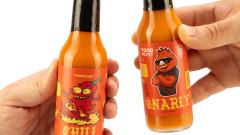WATERMELON DAY: Tips on Carving a Watermelon from a Professional
National Watermelon day is upon us. While the majority of the population is stabbing and slicing away at those juicy fruits, in hopes of tasting its sweet nectar, there are a select few with the talent to carve them into something truly beautiful. One person in particular is Chef Ruben Arroco.
Chef Arroco has been in the culinary business for decades. When he’s not cooking up a delicious meal, he’s hard at work making custom watermelon carvings. Whether it’s birthday, wedding, graduation, or any other type of celebration, the chef will take on the custom job. Provided you give him the proper amount of time, he can turn out a fruitful masterpiece that will make your jaw drop and tongue salivate.
I got the chance to speak with Chef Arroco, a professional watermelon carver, to see if he could give me some pro-tips on how to dip my feet into the world of watermelon carving. Mind you, I was a blank slate, with the ability to carve nothing more than a jack-o-lantern looking watermelon.
Here’s my first attempt before speaking to him. As you can see, it’s pretty damn awesome.
While I didn’t think there was any more room for improvement, my fellow staff members encouraged me to do the interview anyways to see if I could fine-tune my watermelon carving skills. Luckily, Chef Arroco was more than happy to help share a few notes.
—–

Picking the perfect melon
Chef: Since I do a lot of people’s faces or letters, I look for the greenest watermelon I can find. That way the letter or artwork that I’m doing will show more color. Of course, the bigger the watermelon the better.
I tap the watermelon. The sound that you can hear is a solid sound and it needs to be firm, not soft at all. The watermelon will also be heavy, which means it’s nice and juicy. Watermelons are the easiest to work with.
The right knife
Chef: This carving is actually an old art from Thailand. They use a small paring knife. I bought a bunch of hi-quality paring knives. Basically with this kind of art, you can do everything with just a small paring knife.
Griping the knife
Chef: You have to have really good control of the knife otherwise you can over cut. It’s like when you’re writing something using a pen: you anchor your hand and control the flow of your pen as you’re wiring. I’m actually using my pinky and thumb to anchor my hand when I’m cutting it.
Depending how deep I am cutting the watermelon, I put my pointer finger exactly where I want the pen to go through the melon and how deep.
Equipment
Chef: I have a turntable and I have a kitchen towel. I take the towel and fold it into a circle so that the watermelon doesn’t move around.
——
It should also be noted that some creativity will be needed to make this happen. Similar to sculpting, a visual eye for details is definitely recommended when carving a watermelon. Also, years of practice doesn’t hurt.
While I didn’t have those years of experience, I was able to make the best use of Chef Arroco’s advice. After speaking with him, I’d like to think there was some improvement on my second try.

I think designer Chris agrees.




























